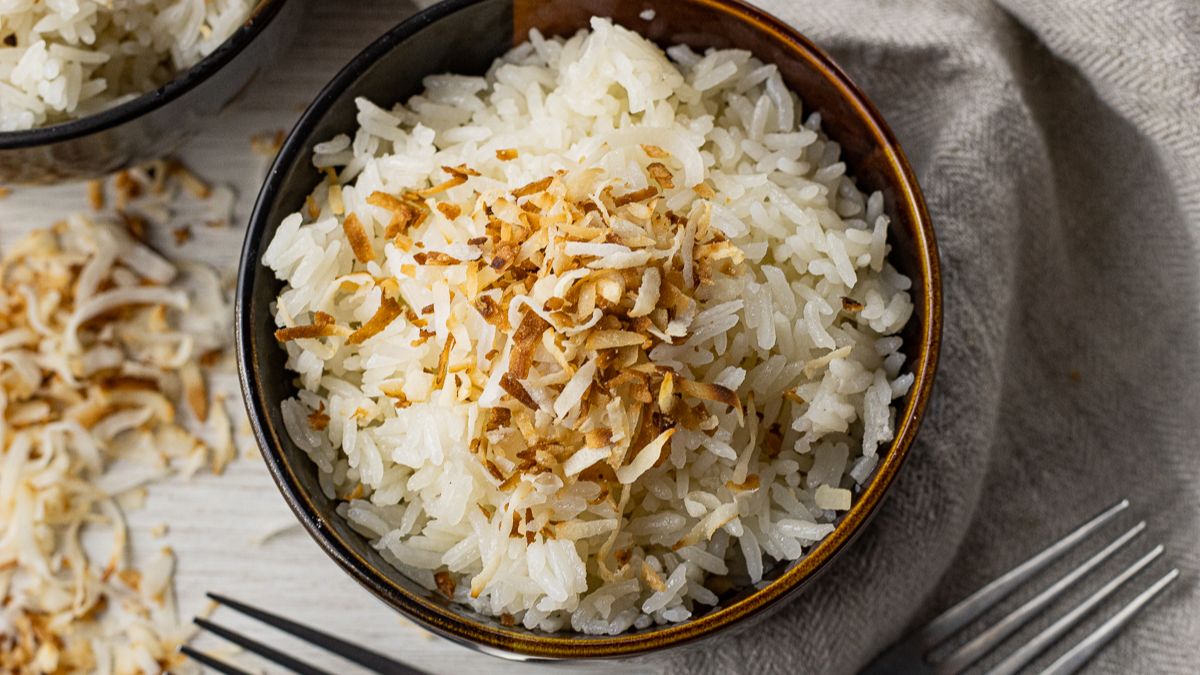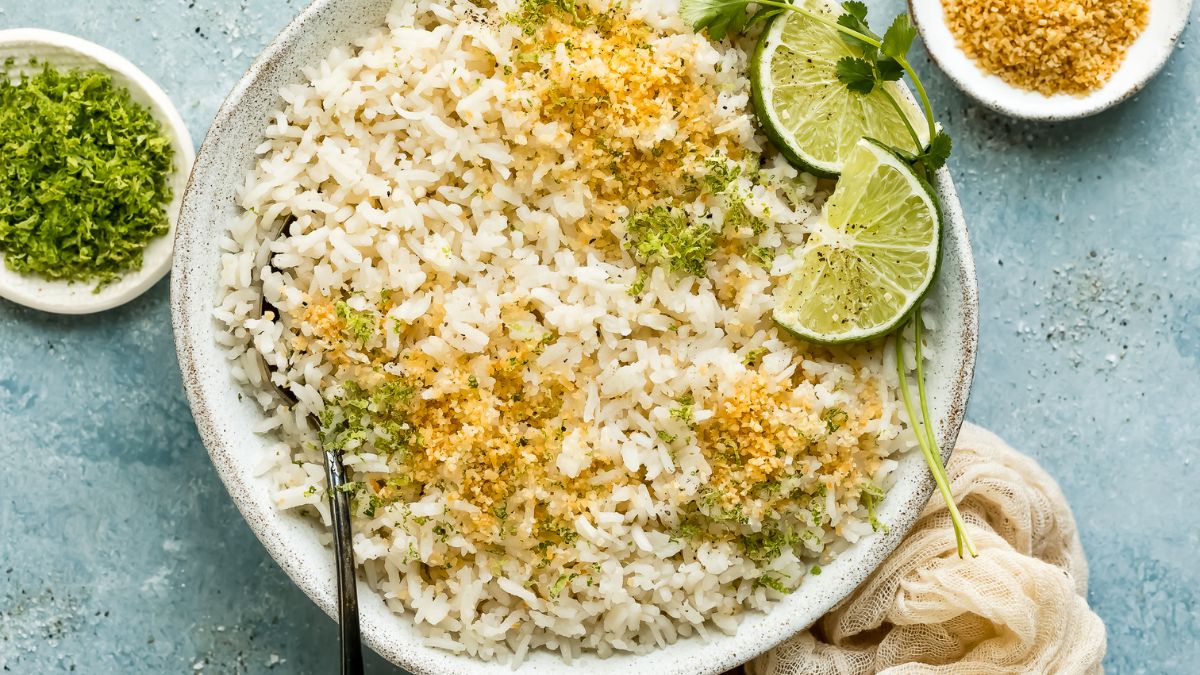Coconut Rice is a popular and common rice-based dish in the South Indian areas. This recipe is easy to prepare by combining cooked rice with sautéed or fried lentils, herbs, spices, and coconut. Coconut rice can be used in desserts in addition to being served with savory dishes. A tiny amount of sugar is typically added during the cooking process to coconut rice when using it in desserts so that the rice will be sweet. As a simple dessert option for the traditional Thai dish of sticky rice with mango, coconut rice topped with fruit and syrup may be delectable.
What is Coconut Rice?
How to Make Coconut Rice?
Soak Rice & Lentils
- Soak 1 cup of ordinary, non-sticky Indian rice in water for 20 to 30 minutes (for example, sona masuri, ponni, surti kolam, or basmati rice).
- Also, soak 12 tablespoons of chana dal and urad dal in hot water for 20 to 30 minutes. Black gram is split and husked to make urad dal. Bengal gram is split and husked to make chana dal.
When preparing the recipe, you can add the lentils without first soaking them. However, soaking them enhances their flavor and gives the rice a better texture. After that, thoroughly drain the water, and set the lentils aside.
Cook Rice
- Drain the water after a 20 to 30-minute period. Add the rice to a 2-liter pressure cooker and 1.75 to 2 cups water.
Pressure On medium-high heat, cook the rice for two whistles, equal to 5 to 6 minutes. Open the cooker’s lid when the pressure naturally decreases and fluff the rice.
Pressure cook the rice for three whistles to give it a softer texture. Rice can be prepared in a pot, pan, or Instant Pot if you don’t have a pressure cooker. The specifics are mentioned below.
Fry Spices, Lentils
- 5. Warm up a pan with two teaspoons of coconut oil. Additionally, you can use any other neutral oil or sesame oil—not the toasted Asian variety, but the oil obtained from raw sesame seeds, often known as gingelly oil.
- Add one teaspoon of mustard seeds, reduce the heat, and watch the seeds crackle.
- Add the strained chana dal and urad dal when the mustard seeds begin to crackle. On low heat, combine and cook for one minute.
- Include two tablespoons of chopped cashews.
- Stir and cook the cashews until they turn golden. By then, the lentils would likewise turn golden.
- Add a sprinkle of asafoetida, 1 or 2 dry red chilies (broken and seeds removed), 10 to 12 curry leaves, and 1 or 2 chopped green chilies (approximately 1/2 to 1
- teaspoon minced) (thing). For gluten-free rice, skip the asafoetida or use gluten-free asafoetida.
- Stir and fry until the red chilies change color. The curry leaves would also become crisp.
Add Coconut
- Add 1.5 cups of finely grated coconut after that. Ensure the grated coconut is finely ground—avoid chunkier or bigger shreds.
- Combine and mix very well with the rest of the fried spices and herbs.
- Sauté the coconut on low heat for 3 to 4 minutes, stirring often. The coconut can be sautéed until it gets a cream-ish or faint, pale beige color.
Make Coconut Rice
Lastly, add the steamed, cooled rice and salt to your taste.
Mix the rice very well and switch off the heat.
How to Serve & Storage?
Serve the warm or hot coconut rice. If desired, garnish with chopped coriander leaves and drizzle a little ghee over the dish as it is being served. While eating the rice, you can also decide to sprinkle some lemon juice over it. Coconut rice can be served on its own or with gravy or curry, such as vegetable stew, potato roast, vegetable kurma, cauliflower kurma, or even plain fresh curd at home. This rice is best eaten fresh because it contains coconut. The likelihood of the coconut getting rotten is very high. Thus, I do not advise storing this rice in the refrigerator. Furthermore, eating rice that has just been cooked is excellent.
Expert Tips
Rice: In this recipe for coconut rice, any short- or medium-grained rice works well. However, whichever rice you choose, it must not be sticky. You can use any non-sticky variety of Indian rice in this recipe. Another alternative for making this delicious coconut rice recipe is fragrant basmati rice.
Coconut: Freshly grated coconut should be used for the greatest flavor and taste, in my opinion. Comparing the flavor of fresh coconut rice to that of unsweetened desiccated coconut will not yield a better result. The next choice is frozen coconut. Make sure your frozen coconut smells fresh and isn’t stale.
Lumpy rice: After cooling, the rice grains become lumpy and overcooked. Be at ease. The cooked rice’s lumps should be easily broken.
Herbs: The flavor of curry leaves is quite flavorful in thengai sadam. Since curry leaves are a necessary component of the dish, no other herb or spice can be used in its place. In the absence of curry leaves, I advise using curry leaf powder. Add roughly 1/2 to 1 teaspoon of powdered curry leaves.
Nuts: Peanuts can be substituted with cashews, which I prefer to use. If you don’t have these nuts on hand, omit them.
Lentils: The meal is given a nutty taste and some wonderful crunch by the fried toasted lentils. If you don’t like them or don’t have any in your pantry, skip them.
How is Coconut Rice Good for Health?
According to health professionals, consuming coconut is helpful for digestion, relieving stress, boosting immunity, and preserving healthy skin and hair. As a result, coconut-infused rice may also be good for your health. Interestingly, coconut rice is so nourishing. Although the coconut milk (extracted from the coconut) used to prepare the rice has a lot of saturated fat, it is healthier than other items that include saturated fat since the body can readily process it. With the addition of coconut, rice becomes fiber-rich and helps to boost metabolism, making it a perfect addition to a diet plan for losing weight.
Conclusion
Coconut rice can be paired with curry, Dahi, papad, salad, or vegetable korma. You can choose this dish when you don’t have time in the kitchen. Try this dish for a quick lunch on those hectic days when you work from home. With the addition of coconut, rice becomes fiber-rich and helps to boost metabolism, making it a perfect addition to a diet plan for losing weight. According to health professionals, consuming coconuts is helpful for digestion, relieving stress, boosting immunity, and maintaining healthy skin and hair.

